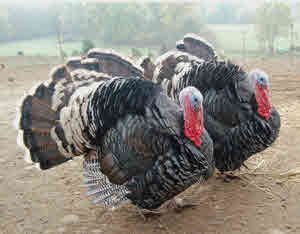 Turkey Rearing: Good Stock
Turkey Rearing: Good Stock
If rearing your own potential breeding stock, look for a uniformity of size, shape and colouring, and only keep the best for breeding on. Maintain detailed records so that you know which are the healthy, vigorous birds with good production.
Tag or ring the birds that are kept, with details of their parentage. Change stags regularly to avoid inbreeding.
Hen birds producing poor quality poults should be removed from the breeding programme.
Maintaining these standards and separating and culling sub-standard birds will lead to better stock to sell to customers.
To achieve these goals esffectively, quite a number of birds may need to be kept. The greater the number, the greater the opportunity to improve the quality of the stock from one season to the next.
Therefore, for the smallholder or small-scale breeder hoping to produce good birds to sell on, there is a case for concentrating at the outset on just one breed, such as bronze or black turkeys where there is likely to be a ready market.
Breeder Management
Both stags and hens should have identification tags or rings so that accurate records can be kept for each of the birds. They are available from specialist suppliers.
A breeding ratio of one stag to ten hens is the right proportion. Fewer hens may lower the overall fertility. Conversely, having too many hens will produce the same effect. This is a generalisation, for there can be considerable variation, with heavier breeds often having a lower ratio.
Turkeys start to lay eggs from 28 – 30 weeks onwards. They lay most eggs in their first year, with numbers decreasing in the second year and again in their third year. Stags are also at their most fertile in their first year so using young birds to produce poults for sale gives the best results. A stag used for a second season will have a reduced fertility.Balanced against this, is the fact that performance will be a known quantity from the second year, if accurate records have been kept.
It is a good idea to keep some stags in reserve in case one is needed. Reserve stags should be penned out of sight of the breeding flock to prevent over-excitability.
If a stag is inactive or if the eggs produced after his mating activity are not fertile, he will need to be replaced.
This article is a shortened extract from Starting with Turkeys by Katie Thear and used with permission of the publisher.
Further Articles on Keeping Turkeys
- Breeding Turkeys – Genetics & Stock
- Breeding Turkeys – Incubating & Hatching Turkey Eggs
- Breeding Turkeys – Introducing Sexes & Mating Turkeys
- Breeding Turkeys – Turkey Rearing: Good Stock
- Guide to Keeping Turkeys – Housing & Feeding Turkeys
- Guide to Keeping Turkeys – Introduction & Turkey Breeds
- Guide to Keeping Turkeys – Turkey Diseases
- Guide to Keeping Turkeys – Turkey Health
- Guide to Keeping Turkeys – Turkey Parasites & Poison

